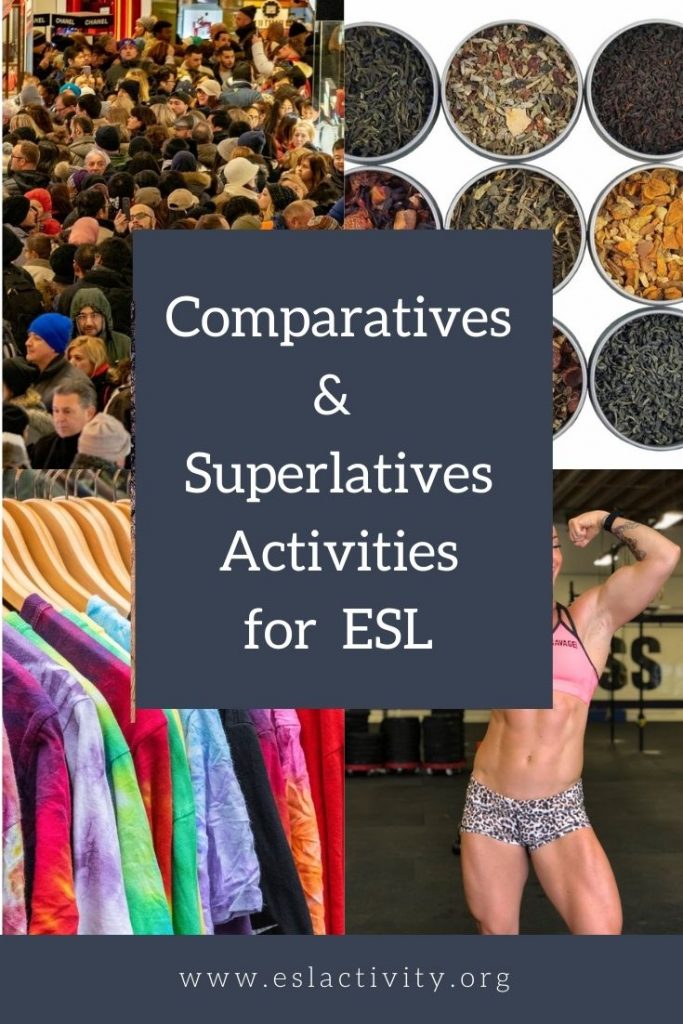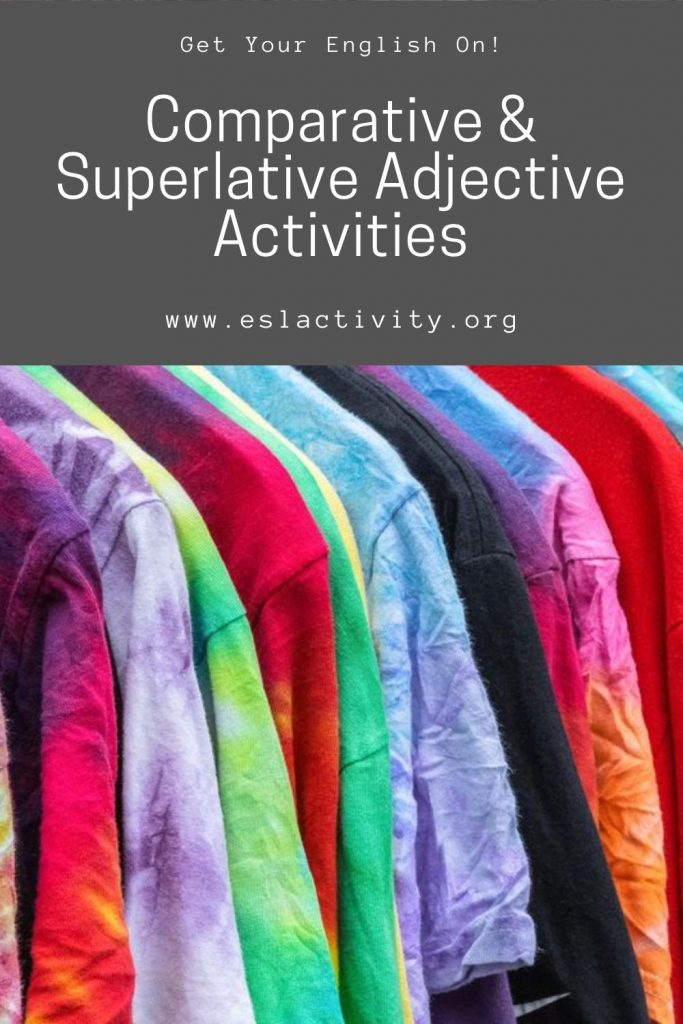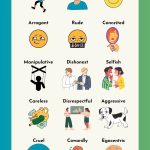If you’re looking for some of the best comparative and superlative adjective games and activities, then you’re in the right place. You’ll find plenty of those, along with comparing adjectives lesson plans, worksheets and other resources.

Adjectives that compare games and activities
Comparative & Superlative Adjectives: Activities and Games
What is a comparative? It’s an adjective that compares two things. For example, bigger, dirtier, more beautiful.
What is a superlative? It’s an adjective that expresses something of the highest quality or degree. For example, biggest, dirtiest, most beautiful.
Now that that’s out of the way, let’s get into the best superlative games and ideas, along with comparatives activities!
#1: ESL Surveys for Comparatives and Superlatives
Just ask my students and they’ll tell you that I love to use surveys in my classes. I use them at least once a month in a variety of contexts and comparative and superlatives are a natural fit. Here are just a few of the questions that you could use:
- Do you think that the best hockey team is the (your local team)?
- Is eating junk food your worst habit?
- Do you think that Coke is more delicious than Pepsi?
Find out more here: ESL Surveys and Questionairres.
#2: Running Dictation
#3: Man/Woman on the Street Interview Activity
I love this activity because it takes something old (interviewing) and makes it new again by adding in an element of fun. Students have to interview each other with a fake microphone, using a question with a comparative or superlative. Based on the answer that they get, they have to ask some follow-up questions. Learn more about it:
Man/Woman on the Street Interview ESL.
#4: Superlative Country Quiz
#5: Error Correction Relay Race
I love to pull out this activity once in a while because it takes something old (error correction) and makes it new again. It’s a fun way for students to focus on both form and meaning of comparative and superlatives. Have a look:
#6: Dialogue Substitution for Comparative and Superlative Adjectives
#7: Information Gap Activities
An information gap activity is one where each student in a pair only has part of the information. The students have to talk together, in English in order to get the complete picture.
There are a number of options for this style of activity for comparative or superlative adjectives. You may even be able to find one such activity in the teacher resource book that comes with your textbook.
It’s also easy to make your own with something like buildings or people. You can use words like oldest, youngest, tallest, shortest, smallest, etc. Find out more about this kind of activity here:
#8: Picture Prompt Comparative and Superlative Adjective Activity
#9: Flashcard Games and Activities
A nice option for teaching comparatives and superlatives is to use flashcards. There are a ton of fun games you can use to work on this important English grammar point. Have a look here for some of the best ideas:
#10: Comparative and Superlative Adjective Videos
There are a million and one ways to use video in the English language classroom. Plus, there are so many videos that feature these kinds of adjectives. Have a look on English Central or YouTube and you’ll be able to find something that’ll work in just a few minutes.
Beyond that, there are lots of ideas for how to use these videos in the class. Have a look at some of the best ideas here:
Using Video in the ESL Classroom.
#11: Dictogloss
#12: Me Too!
This is a very simple speaking and listening activity for beginners. Students have to write down a true statement about themselves using a comparative or superlative. For example:
- The best fast food restaurant is Burger King.
- I’m taller than my brother.
They take turns saying the statement to the class and if the statement is also true for other people, they can stand up and say, “Me too!”
#13: Is that Sentence Correct?
This is a simple error correction activity that works well for superlative/comparative adjectives. I like to level-up the difficulty by having errors in both form (My bedroom is the dirtyest in my house) and meaning (Cars are smaller than bicycles).
Students have to say whether or not the sentence is correct and if not, they have to correct it. Find out more here:
#14: Vocabulary Auction
#15: Mixed Up Sentences
For beginners, word order in comparative sentences can be a little bit tricky. Which noun comes first and which one is second? That’s why I like to use this simple activity to give my students a bit of practice with that. Check it out:
#16: Dictation Practice for Comparatives and Superlatives
Okay, I know that dictation is a bit old-school when it comes to language learning. However, it does still have some value in the classroom. I like to pull it out to make sure my students really know the rules for the endings (dirtiest, most beautiful, tallest, etc.). Check it out:
#17: Hot Potato
#18: Postcards Writing Activity
This is a fun activity where students have to pretend they’re on vacation and write a postcard to a friend or family member. In this case, I require my students to use at least a few superlatives:
- I’m having the best time.
- The food was the worst.
- There was the biggest rainstorm.
Check it out:
Postcards ESL Writing Activity.
#19: Use an ESL Reading Lesson for Comparative and Superlative Adjectives
One of the ways that I love to introduce these kinds of adjectives is through a reading lesson. First, set the context. Then, have students do the reading, along with some questions. Then, students can have a look to find the comparatives and superlatives and try to deduce some rules about them. Find out how to plan this style of lesson right here:
ESL Reading Lesson Plan Template.
#20: Fun Games for Teaching Superlatives and Comparatives
#21: Comparative Pairs
Put students into pairs. They need to come up with 2-5 (depending in the level and time allowed) true statements about the two of them. For example:
- Tommy is taller than me.
- His bag is bigger than mine.
#22: Comparative Adjectives Quiz
Have some fun with this online quiz for comparatives (for beginners)
#23: Comparative Card Game
Make up a deck of cards or use flashcards that you might have lying around the teacher’s room. Put students into small groups and the first student draws two cards. Then, they have 10 seconds to make a sentence using a comparative adjective. The other students can count down on their fingers. Some examples:
- (apples, carrots) Apples are sweeter than carrots.
- (soccer, TV) Soccer is more active than watching TV.

Comparative and superlative adjective games and activities
Comparative and Superlative ESL Lessons Plans
If you’re a teacher then you already know how much time it can save you to use what other teachers have created. Why reinvent the wheel, right? That’s why you’ll want to check out these lesson plans for comparative and superlative adjectives.
Comparative Superlative Worksheets
No need to make your own worksheets! There are so many great options for all ages and levels. Here are some of the top options for comparative and superlative adjective worksheets:
Did you like these Ideas for Teaching Comparatives and Superlatives?
- Amazon Kindle Edition
- Bolen, Jackie (Author)
- English (Publication Language)
- 112 Pages - 10/24/2019 (Publication Date)
Yes? Then you’re going to love this book: 39 No-Prep/Low-Prep ESL Grammar Games and Activities. The key to better English classes is a wide variety of interesting and engaging activities. This book will help you get there in style.
Pick up your copy of the book today and get ready for better English lessons tomorrow:
FAQs
There are a number of common questions that people have about teaching this unit. Here are the answers to some of the most common ones.
What are comparatives and superlatives?
Comparatives and superlatives are forms of adjectives and adverbs used to compare two or more things. Comparatives compare two things, while superlatives express the highest degree of comparison.
How do you form comparatives?
Comparatives are usually formed by adding “-er” to the end of the adjective or adverb for short words, or by adding “more” before the adjective or adverb for longer words.
How do you form superlatives?
Superlatives are usually formed by adding “-est” to the end of the adjective or adverb for short words, or by adding “most” before the adjective or adverb for longer words.
Can you give me some examples of comparatives?
Sure! Examples of comparatives include: “bigger,” “faster,” “more beautiful,” “smarter,” “less expensive.”
Can you give me some examples of superlatives?
Certainly! Examples of superlatives include: “biggest,” “fastest,” “most beautiful,” “smartest,” “least expensive.”
How do you use comparatives in a sentence?
Comparatives are used to compare two things. For example: “This car is faster than that one.”
How do you use superlatives in a sentence?
Superlatives are used to express the highest degree of comparison. For example: “Mount Everest is the tallest mountain in the world.”
Superlative and Comparative Adjectives: Join the Conversation
Do you have any fun superlative ideas or comparative adjective games? Leave a comment below and let us know about it. We’d love to hear about it.

Superlative Ideas for English Classes
Last update on 2022-07-17 / Affiliate links / Images from Amazon Product Advertising API






